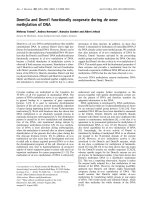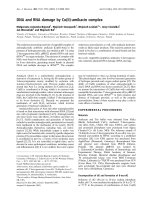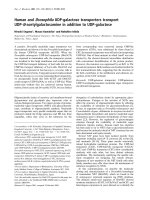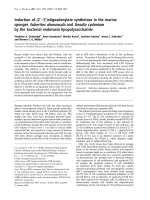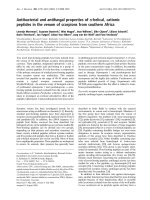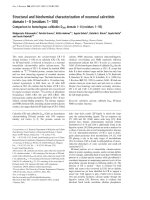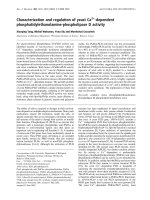Báo cáo y học: " Induction and effector phase of allergic lung inflammation is independent of CCL21/CCL19 and LT-beta
Bạn đang xem bản rút gọn của tài liệu. Xem và tải ngay bản đầy đủ của tài liệu tại đây (870.69 KB, 8 trang )
Int. J. Med. Sci. 2009, 6
85
I
I
n
n
t
t
e
e
r
r
n
n
a
a
t
t
i
i
o
o
n
n
a
a
l
l
J
J
o
o
u
u
r
r
n
n
a
a
l
l
o
o
f
f
M
M
e
e
d
d
i
i
c
c
a
a
l
l
S
S
c
c
i
i
e
e
n
n
c
c
e
e
s
s
2009; 6(2):85-92
© Ivyspring International Publisher. All rights reserved
Research Paper
Induction and effector phase of allergic lung inflammation is independent
of CCL21/CCL19 and LT-beta
Corinne Ploix
1
, Riaz I. Zuberi
2
, Fu-Tong Liu
3
, Monica J. Carson
4
, and David D. Lo
4
1. Roche Ltd., Basel, Switzerland
2. La Jolla Institute for Molecular Medicine, La Jolla, CA, USA
3. Department of Dermatology, School of Medicine, University of California, Davis, CA, USA
4. Division of Biomedical Sciences, University of California, Riverside, CA, USA
Correspondence to: David D. Lo, M.D., Ph.D., Division of Biomedical Sciences, University of California, Riverside, CA.
phone: 951-827-4553, fax: 951-827-5504, email:
Received: 2009.02.17; Accepted: 2009.03.06; Published: 2009.03.10
Abstract
The chemokines CCL21 and CCL19, and cell bound TNF family ligand lymphotoxin beta
(LTβ), have been associated with numerous chronic inflammatory diseases. A general role in
chronic inflammatory diseases cannot be assumed however; in the case of allergic inflam-
matory disease, CCL21/CCL19 and LTβ have not been associated with the induction, re-
cruitment, or effector function of Th2 cells nor dendritic cells to the lung. We have exam-
ined the induction of allergic inflammatory lung disease in mice deficient in CCL21/CCL19 or
LTβ and found that both kinds of mice can develop allergic lung inflammation. To control for
effects of priming differences in knockout mice, adoptive transfers of Th2 cells were also
performed, and they showed that such effector cells had equivalent effects on airway hy-
per-responsiveness in both knockout background recipients. Moreover, class II positive an-
tigen presenting cells (B cells and CD11c+ dendritic cells) showed normal recruitment to
the peribronchial spaces along with CD4 T cells. Thus, the induction of allergic responses
and recruitment of both effector Th2 cells and antigen presenting cells to lung peribronchial
spaces can develop independently of CCL21/CCL19 and LTβ.
Key words: asthma, dendritic cell, Th2, chemokine
Introduction
The membrane-bound cytokine lymphotoxin
beta (LTβ) is known to be important in the early
stages of secondary lymphoid tissue development.
Signaling by LTα1/β2 ligands through the LTβ-R in-
duces development of the stromal cells of secondary
lymphoid tissues [1]. The stromal cells provide or-
ganization to these lymphoid tissues in large part by
producing the chemotactic CCR7 ligand CCL21,
which recruits both lymphocytes and dendritic cells,
signaling through the chemokine receptor CCR7 [2,3].
LTβ-deficient mice show greatly impaired immune
responses [4-6]; likewise, immune responses are sig-
nificantly delayed in CCL21 deficient mice [7]. The
tissue site and mechanism of induction of immune
responses in these mutant mice remain unclear.
Interestingly, several acute and chronic inflam-
matory diseases also appear to have a strong de-
pendence on LTβ and CCL21 during their effector
phase. Thus, blockade of LTβ-R will significantly in-
hibit graft-versus-host-disease [8,9], experimental
colitis [10,11], and autoimmune diabetes [12]. Simi-
larly, strong local CCL21 induction was found to be
Int. J. Med. Sci. 2009, 6
86
associated with autoimmune diabetes [13], chronic
liver inflammation [14,15], multiple sclerosis [16] and
Experimental Autoimmune Encephalomyelitis
[17,18], rheumatoid arthritis [19], Sjogren’s syndrome
[20], and inflammatory skin diseases [21-25]. In addi-
tion, CCL21 appears to have a role in regulating CD4
T cell homeostatic proliferation and effector cell de-
velopment; an excess of CCL21 was found to be suffi-
cient to drive autoimmune diabetes [26]. Most of the
inflammatory responses described above arguably
fall into the category of Th1-mediated effector mecha-
nisms. Moreover, they are often associated with local
development of lymphoid follicle structures (e.g.,
Sjogren’s syndrome, rheumatoid arthritis, autoim-
mune diabetes) in a process that resembles LTβ- and
CCL21-dependent secondary lymphoid tissue devel-
opment (“lymphoid neo-organogenesis,” [27]).
Thus, to determine whether a similar depend-
ence on LTβ and CCL21 is present in Th2-mediated
effector mechanisms in the lung, we studied the in-
duction of allergic lung inflammation in LTβ and
CCL21/CCL19 deficient mice. We found that both
kinds of mutant mice mounted normal or enhanced
Th2 responses as measured by eosinophil recruitment
and increased airway resistance. Recruitment of CD4
T cells, B lymphocytes, and CD11c+ dendritic cells to
the peribronchial space was also normal. Our results
show that the initiation and effector phase of allergic
lung inflammation is independent of LTβ and CCL21.
Materials and Methods
Mice
LTβ knockout mice (“LTβ-KO”) backcrossed to
C57BL/6 were kindly provided by Dr. S. A. Ne-
dospasov [1], and plt/plt (“plt”) mutant mice which
lack expression of the CCR7 ligand chemokines
CCL21 and CCL19 [2], backcrossed to BALB/c, were
generously provided by Dr. A. Matsusawa. Mice
were bred and maintained under specific patho-
gen-free conditions in accordance with NIH and in-
stitutional guidelines.
For the adoptive transfer studies in Figure 3B,
adoptively transferred CD4 T cells were taken from
donors matching the genetic background of the re-
cipient. Thus, C57BL/6 mice were used as donor of
CD4 T cells for C57BL/6 and LTβ-KO mice while plt
recipients were injected with cells from BALB/c mice.
Transfer recipients were 6-8 weeks old. Although the
mutant mice studied were on two different back-
grounds, the strain specific controls (e.g., challenged
with PBS) were used in each case. In addition, we
found that control mice on C57BL/6 and BALB/c
background strains could both be induced to develop
robust allergic lung inflammation.
Induction of allergic lung inflammation
Naïve mice were injected i.p. at day 0 and day 7
with 10 µg chicken egg ovalbumin (Sigma) in 100 µl
of PBS mixed with 100 µl of Imject Alum (Pierce,
Rockford, IL). One week later, immunized mice were
challenged intra-nasally with 25 µl OVA (2 mg/ml)
or PBS once per day for 3 consecutive days.
For adoptive transfer experiments, naïve mice
were injected i.p. at day 0 and day 7 with 10 µg
chicken egg ovalbumin (Sigma) in 100 µl of PBS
mixed with 100 µl of Imject Alum (Pierce, Rockford,
IL). One week later, immunized mice were chal-
lenged intra-nasally with 25 µl OVA (2 mg/ml) or
PBS once per day for 3 consecutive days. Splenic CD4
T cells were purified on day 14 using magnetic beads
and were i.v. injected (5x10
6
cells/mouse). The phe-
notype of the donor CD4 Th2 cells was confirmed by
real-time PCR analysis of RNA for IL-2, IL-4, IFNγ,
and HPRT, and calculating the IL-4/IFNγ ratios. In-
tranasal challenge was performed on day 14, 15 and
16 (days 0, 1, and 2 after transfer) as described previ-
ously [28,29].
T cell transfer
Spleens were aseptically removed and single cell
suspensions were prepared by mechanical dispersion
according to standard procedures in Hanks' balanced
salt solution (HBSS). CD4 T cell enriched populations
were obtained by elimination of B cells and macro-
phages by incubating for 30 min on ice with rat anti
mouse CD45R/B220, anti-CD8, M5/114 and F4/80
antibodies (PharMingen, San Diego, CA). Cell sus-
pensions were then incubated for 30 min on ice under
constant agitation with magnetic beads coated with a
sheep anti-rat IgG covalently linked Abs (Dynabeads
M-450, Dynal, Oslo, Norway) at a bead to cell ratio of
20:1. Non-adherent cells were collected after the re-
moval of free and cell bound beads using a magnetic
bead concentrator (Dynal, MPC 6). The resulting cell
populations comprised more than 90% CD4+ cells by
flow cytofluorometry using a FITC-labeled
anti-mouse CD4 antibody (Pharmingen) on a FAC-
Scan flow cytometer (Becton Dickinson, Mountain
View, CA). Five million splenic CD4 T cells from do-
nor mice were injected i.v.
Bronchoalveolar lavage (BAL)
BAL was performed 3 hours after the last i.n.
challenge using 3x 1ml of RPMI 2% FCS. Cells were
counted and resuspended at a final concentration of
Int. J. Med. Sci. 2009, 6
87
5x10
5
cells/ml. Cytospin slides were fixed with
methanol and stained with Diff-Quick (Fisher Scien-
tific, Pittsburgh, PA). Eosinophils, mono-
cytes/macrophages and lymphocytes were enumer-
ated based on morphology and staining and ex-
pressed as percentages of total BAL cells [28,29].
Histology
Frozen lung sections were fixed in 1% forma-
mide-acetone and stained for cyanide-resistant per-
oxidase activity as previously described [28,29]. Other
sections were stained with rat anti-mouse CD4
(PharMingen) followed by biotin F(ab’)
2
mouse
anti-rat IgG (Jackson Immunoresearch, West Grove,
PA) and streptavidin-FITC (Jackson). APCs, dendritic
cells and B lymphocytes were visualized using re-
spectively M5/114, anti-CD11c and anti-B220 Abs
(culture supernatant and PharMingen) followed by
biotinylated secondary Ab and strepta-
vidin-rhodamine or streptavidin-FITC. For dendritic
cells, the signal was amplified using TSA-indirect kit
according to manufacturer’s instructions (NEN Re-
search Products, Boston, MA) and revealed by strep-
tavidin-Rhodamine (Jackson Immunoresearch).
Airway reactivity measurements
Airway hyper-responsiveness (AHR) to meta-
choline (Acetyl-β methylcholine chloride, Sigma) was
assessed 24 hours after the last intranasal challenge.
Briefly, mice were maintained inside a whole-body
plethysmograph (Buxco, Troy, NY) capable of meas-
uring changes in airflow and trans-thoracic pressures
and resistances [30]. After establishing a stable base-
line for total lung resistance, mice were exposed to
aerosols of saline or metacholine in increasing con-
centrations (1 to 50 mg/ml) for 3 min. Enhanced
pause (Penh) index values reflecting changes in the
waveform of pressure signal from both inspiration
and expiration combined with the timing were calcu-
lated and averaged for 3 min after each nebulization.
Results
Allergic lung inflammation in mutant mice
In previous studies, it was found that robust
lung eosinophilia could be rapidly induced in mice,
requiring only the adoptive transfer of a small num-
ber of antigen specific Th2 cells combined with anti-
gen challenge [28, 31-33]. These results suggested that
lung allergic inflammation was not dependent on any
“conditioning” of the lung by antigen specific effector
cells (e.g., expressing LTβ), prior antigen exposure, or
the presence of allergen specific IgE. Moreover, the
rapid kinetics of the inflammation suggested that
presentation of antigen in the lung parenchyma
might be sufficient to trigger the cascade of cytokines
and chemokines necessary for tissue eosinophilia
without involvement of draining lymphoid tissues.
We studied the induction of lung allergic in-
flammation in mice lacking LTβ (lymphotoxin-beta
knockout, or LTβ-KO [1]) or CCL21/CCL19 (plt mu-
tant [2]). In initial studies, control, LTβ-KO, and plt
mutant mice were immunized with OVA according
to a protocol previously established to induce allergic
lung inflammation in normal mice [28,29]. Figure 1
shows that robust lung eosinophilia was generated in
all mice at equivalent levels (though possibly in-
creased in LTβ-KO mice), suggesting that both Th2
priming and lung eosinophilia were not impaired by
either the LTβ or CCL21/CCL19 defects. The histol-
ogy of eosinophil infiltration was also unaffected in
the mutant mice, as dramatic peribronchial and
perivascular infiltration was produced in all mice
(Figure 2).
Figure 1: Eosinophilia in BAL: C57BL/6J (white bars),
LTβ-KO (black bars) and plt/plt mice (grey bars), were
immunized and challenged i.n. with OVA as described in
material and methods section. Three hours after the last i.n.
injection lung cells were harvested by lavage, counted and
submitted to cytospin for analysis of the composition of the
BAL. Control C57BL/6J mice (hatched bars) were not
immunized but were challenged i.n. with OVA. Results
summarize 4 independent experiments with 3 mice per
group (12 mice total for each condition).
Int. J. Med. Sci. 2009, 6
88
Figure 2: Histology of lung infiltrates: C57BL/6J
mice (A, B), LTβ-KO (C) and plt/plt mice (D)
were i.p. immunized and i.n. challenged with
OVA (B, C, D) or PBS (A). Lungs show peri-
bronchial and perivascular accumulation of
eosinophils in mice challenged with OVA but not
in those challenged with PBS. Sections were
stained with DAB in the presence of cyanide to
reveal eosinophil peroxidase activity. Slides were
counterstained with H&E. All pictures are at the
same magnification (originally photographed at
200x).
Airway resistance in mutant mice
Earlier work suggested that the peribronchial
accumulation of eosinophils was due to local T cell
production of the cytokines IL-4 and IL-13, which in
turn induced epithelial production of the eosinophil
chemokine eotaxin [28]. Since local Th2 cell produc-
tion of cytokines has also been implicated in the in-
duction of increased airway resistance [31,32], we
also tested the mice for airway resistance changes.
Figure 3 shows the results of airway resistance
changes in mice as measured in a whole body
plethysmograph. Mice were challenged with increas-
ing amounts of methylcholine, and calculated Penh
values were used as an estimate of airway resistance.
We found that Penh values were equally increased in
controls, LTβ-KO, and plt mutant mice. Moreover,
when antigen specific Th2 cells were transferred from
wild type mice to naïve mutant mice, increases in
airway resistance were also increased to levels exhib-
ited in wild type mice. Thus, Th2 effector responses
leading to changes in airway resistance were also not
dependent on either LTβ nor CCL21/CCL19.
Antigen presenting cell recruitment in the lungs
of mutant mice
Antigen presenting cells or their precursors are
generally present within nearly all tissues, presuma-
bly serving a kind of sentinel function. Inflammatory
stimuli such as TNF and endotoxin are extremely ef-
fective in inducing resident tissue antigen presenting
cells to become activated antigen presenting cells,
which then migrate to draining lymph nodes to
stimulate cellular immune responses [34]. The migra-
tion of activated antigen presenting cells to the
draining lymph nodes is considered to be in large
part dependent on CCL21-dependent chemotaxis
[2,3]. In addition, while LTβ-KO mice have grossly
normal dendritic cell subsets [5, 35], immune re-
sponses can be impaired, perhaps due in part to de-
fects in homing or recruitment of dendritic cells. Thus
it was possible that LTβ or CCL21 deficient mice
would show altered recruitment of antigen present-
ing cells to the lung parenchyma.
To examine the recruitment of candidate antigen
presenting cells, we studied the presence and distri-
bution of class II MHC positive cells within the sites
of inflammation in the lung as previously described
[36]. Figure 4 shows that class II MHC positive cells
are abundant within the perivascular and peribron-
chial spaces of inflamed lung tissue in both control
and mutant mice. In these infiltrates, eosinophils are
also present, along with numerous CD4 T cells.
However, while infiltrates in some immune mediated
inflammatory diseases show spontaneous organiza-
tion into distinct T cell and B cell dependent com-
partments, allergic lung infiltrates were rather disor-
ganized.
Next, we examined the lung infiltrates for the
character and distribution of two main candidate an-
tigen presenting cell types: namely, B lymphocytes
(B220 positive cells) and dendritic cells (CD11c posi-
tive cells [37,38]). As shown in Figure 5, control,
LTβ-KO, and plt mutant mice all showed similar ac-
cumulations of B220 positive B cells and CD11c posi-
tive dendritic cells. In sum, it is clear that the recruit-
ment of both antigen presenting cell types remains
unimpaired by the absence of LTβ and CCL21.
Int. J. Med. Sci. 2009, 6
89
Figure 3: Airway hyper-reactivity: Twenty-four hours after the last i.n. challenge, airway responsiveness was assessed in i.p.
immunized mice (A) and recipients of antigen specific CD4 T cell transfer (B). Airway sensitivity of C57BL/6J mice (circles),
LTβ-KO (squares) and plt/plt mice (triangles) was tested in the presence of increasing concentration of metacholine. Mice
challenged i.n. with OVA (black symbols) had significantly greater responsiveness to metacholine than their respective PBS
controls (white symbols). Results are shown for 3 mice per group, representing one of two independent experiments.
Figure 4: Organization of infiltrates in the lungs of asthmatic mice: Frozen lung sections from OVA challenged C57BL/6J (A,
D), LTβ-KO (B, E) and plt/plt mice (C, F) were stained for antigen presenting cell and T cell markers. In all 3 groups of mice,
an accumulation of CD4 T cells (A, B, C) and MHC II positive cells (D, E, F) was observed within the lung parenchyma. All
pictures are at the same magnification (originally photographed at 200x).

